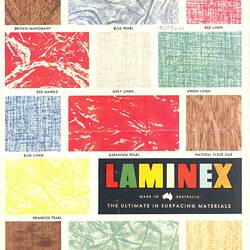Summary
Alternative name: plastic swatch
This Laminex 'Brush Maple Hi Gloss' sample was removed from a Laminex sample set that features 38 double sided plastic laminate swatches and an accompanying product information swatch. The set was thread together by a silver metal chain and stored in a small black cardboard box.
The samples were manufactured in the late 1950s by Laminex Pty Ltd at their plant located at 332 Bay Road Cheltenham, Melbourne. Each of the laminate samples features text identifying the product name, pattern and finish. Colours include a palette of pastels and bold primary colours. Patterns include abstract organic shapes, wood grains, basket weaves, linen prints, metallic threads and flecks. The finish identifies a matt or high gloss appearance, or specifies its suitability for application onto furniture. These samples were used in the mid twentieth century to aid in the selection of colours and patterns for the surface decoration of walls, dining furniture and kitchen, bathroom and laundry cabinetry.
Laminex Pty Ltd was established in 1934 by Robert Sykes and Arthur Beck, in Brighton, Melbourne. It was one of the first companies to manufacture and distribute decorative plastic laminates within Australia. The first plastic laminate sheets, launched in the late 1940s, were approximately 8 x 4 feet in size and featured a limited range of colours and designs. Initially, Laminex products were only distributed to furniture manufacturers and cabinet makers, who fabricated their products with decorative laminates and sold them through show rooms and major department stores. By the early 1950s Laminex was accessible to the public, with the release of 'contact adhesive', a binding agent which enabled the handyman and do-it-yourself enthusiast to apply decorative surfaces within the home. During the 1950s Laminex phased out their operation in Brighton and moved to a larger factory in Cheltenham, Melbourne.
The post World War II housing boom, combined with an increase in household consumption, created an enormous demand for emerging plastic technologies. By the late 1950s, time saving kitchen appliances, hardwearing decorative surfaces and synthetic enamel paints were integrated into domestic architecture. Laminex aimed to revolutionise traditional interior décor schemes by introducing surface treatments that were not only functional and hygienic, but reflected the latest fashion trends. Full page colour advertisements appeared within influential woman's magazines featuring marketing campaigns promoting the 'laminex . lovelier for a lifetime' trade mark. Retail showrooms were also an effective marketing tool, where samples of Laminex products, such as this sample set, were available to be taken home for 'colour matching'.
In 1958 Laminex Pty Ltd was acquired by Australian Consolidated Industries (ACI). During the 1970s, Laminex expanded into the manufacture of substrate materials, such as particleboard and MDF. Laminex established timber mills in Ballarat in 1970 and Wagga Wagga in 1982. By the late 1980s Laminex products were being exported into Asia.
Physical Description
Laminex sample swatch, rectangular in shape, with rounded corners and a small circular hole cut into the top of the sample. Sample is double sided with a colour name printed across the bottom of each side. Light brown wood grain pattern on front; plain light grey colour on reverse. Sample has been removed from a group of 38 sample swatches hung on a silver metal chain.
Significance
This decorative plastic laminate trade sample set is of historical significance as a representation of the widespread domestic application of coloured and textured plastics during the post-war housing boom of the 1950s. It represents the architectural and design sensibilities of the Modernist movement, which was manifest in the fashion trends of the mid twentieth century.
Laminex Pty Ltd was one of the first companies to manufacture and distribute decorative plastic laminates within Australia. Due to its success, in Australia 'laminex' is synonymous with laminate. This company is significant in the history of Australia's interior design and home building / renovation movement, and in relation to the manufacturing of decorative products.
The Laminex product range was launched during the late 1940s and featured 'easy care' plastic sheets in an array of colours, patterns and textures. Colourways referenced popular fashions of the time, with pastels such as 'Coral Pink' and 'Apple Green' representing the 1940s palette, while strong primary colours synonymous with the Modernist movement were included in the range to cater for developing tastes. Patterns included wood grains, marbles, linen weaves, basket weaves and metallic threads, drawing inspiration from the South Pacific and abstracted organic designs.
Since its inception, Laminex Industries has made a wide range of products including kitchen and bathroom surfaces, flooring, architraves, window fittings and skirting boards. Laminex sheeting was applied to a range of domestic items including walls, tables, benches, and chairs. The company has changed ownership several times, and was still a successful business in the early 21st century, 70 years after its establishment.
More Information
-
Collection Names
-
Collecting Areas
-
Acquisition Information
Purchase
-
Manufacturer
Laminex Pty Ltd, 332 Bay Road, Cheltenham, Greater Melbourne, Victoria, Australia, late 1950s
Date Manufactured Notes: Date range estimated from style and colour palette in this sample set, and from preliminary research of the company. -
Inscriptions
Printed on front with blue ink: 'LAMINEX / BRUSH MAPLE / HI-GLOSS' Printed on reverse with blue ink: 'LAMINEX / SARSEN GREY / HI-GLOSS'
-
Brand Names
-
Classification
Building & construction, Painting & decorating, Laminate samples
-
Category
-
Discipline
-
Type of item
-
Overall Dimensions
45 mm (Width), 76 mm (Height)
-
References
[Link 1] A Place like home : a nostalgic journey through the Australian home, Museum of Victoria, Laminex Industries, Museum Victoria, Melbourne, 1994
-
Keywords
Do-It-Yourself (DIY) Products, Home Decorating, Laminate Sheeting, Plastic Laminates, Plastics, Sales Representatives


